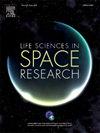综合太空飞行转录组分析和模拟太空实验揭示了在太空飞行的秀丽隐杆线虫的关键分子特征和由太空压力驱动的功能变化。
IF 2.8
3区 生物学
Q2 ASTRONOMY & ASTROPHYSICS
引用次数: 0
摘要
空间环境具有独特的应激源,如微重力和空间辐射,可诱发生物分子和生理变化。为了确定太空飞行的秀丽隐杆线虫的关键可复制转录组特征并探索其潜在的生物学作用,我们整合了国际空间站(ISS)上四次太空飞行的秀丽隐杆线虫的转录组数据,并鉴定了32个可复制差异表达基因(deg)。这些deg富集于与角质层结构组成、防御反应、未折叠蛋白反应、寿命调节、细胞外结构组织和信号受体调节相关的通路中。在这32个基因中,13个基因在四种航天条件下持续下调,主要与角质层的结构成分有关。其余涉及防御反应、未折叠蛋白反应和长寿调节途径的基因,根据太空飞行时间表现出不同的模式:它们在短期太空飞行期间下调,而在长期太空飞行期间上调。为了探索导致这些转录组变化的潜在空间应激源,我们对暴露于模拟微重力和低剂量辐射下的秀丽隐杆线虫进行了qRT-PCR实验。我们的研究结果表明,角质层相关基因的表达在模拟微重力和低剂量辐射条件下均显著下调。相比之下,在模拟微重力条件下,几乎所有涉及防御反应、未折叠蛋白反应和长寿调控途径的基因都下调,而在低剂量辐射下则上调。这些发现表明,微重力和空间辐射都抑制角质层的形成;微重力作为主要应激源,在短期航天飞行中抑制防御反应、未折叠蛋白反应和寿命调节途径,而在长期航天飞行中,空间辐射可能促进这些过程。总之,通过综合的航天转录组分析和模拟太空实验,我们确定了太空飞行秀丽隐杆线虫的关键转录组特征和潜在的生物学功能,揭示了导致这些变化的空间应激源。这项研究为秀丽隐杆线虫对太空飞行的分子和生理适应提供了新的见解,突出了微重力和空间辐射的不同影响。本文章由计算机程序翻译,如有差异,请以英文原文为准。
Integrated spaceflight transcriptomic analyses and simulated space experiments reveal key molecular features and functional changes driven by space stressors in space-flown C. elegans
The space environment presents unique stressors, such as microgravity and space radiation, which can induce molecular and physiological changes in living organisms. To identify key reproducible transcriptomic features and explore potential biological roles in space-flown C. elegans, we integrated transcriptomic data from C. elegans subjected to four spaceflights aboard the International Space Station (ISS) and identified 32 reproducibly differentially expressed genes (DEGs). These DEGs were enriched in pathways related to the structural constituent of cuticle, defense response, unfolded protein response, longevity regulation, extracellular structural organization, and signal receptor regulation. Among these 32 DEGs, 13 genes were consistently downregulated across four spaceflight conditions, primarily associated with the structural constituent of the cuticle. The remaining genes, involved in defense response, unfolded protein response, and longevity regulation pathway, exhibited distinct patterns depending on spaceflight duration: they were downregulated during short-term spaceflights but upregulated during long-term spaceflights. To explore the potential space stressors responsible for these transcriptomic changes, we performed qRT-PCR experiments on C. elegans exposed to simulated microgravity and low-dose radiation. Our results demonstrated that cuticle-related gene expression was significantly downregulated under both simulated microgravity and low-dose radiation conditions. In contrast, almost all genes involved in defense response, unfolded protein response, and longevity regulation pathway were downregulated under simulated microgravity but upregulated under low-dose radiation exposure. These findings suggest that both microgravity and space radiation inhibit cuticle formation; microgravity as the primary stressor inhibit defense response, unfolded protein response, and longevity regulation pathway during short-term spaceflights, while space radiation may promote these processes during long-term spaceflights. In summary, through integrated spaceflight transcriptomic analyses and simulated space experiments, we identified key transcriptomic features and potential biological functions in space-flown C. elegans, shedding light on the space stressors responsible for these changes. This study provides new insights into the molecular and physiological adaptations of C. elegans to spaceflight, highlighting the distinct impacts of microgravity and space radiation.
求助全文
通过发布文献求助,成功后即可免费获取论文全文。
去求助
来源期刊

Life Sciences in Space Research
Agricultural and Biological Sciences-Agricultural and Biological Sciences (miscellaneous)
CiteScore
5.30
自引率
8.00%
发文量
69
期刊介绍:
Life Sciences in Space Research publishes high quality original research and review articles in areas previously covered by the Life Sciences section of COSPAR''s other society journal Advances in Space Research.
Life Sciences in Space Research features an editorial team of top scientists in the space radiation field and guarantees a fast turnaround time from submission to editorial decision.
 求助内容:
求助内容: 应助结果提醒方式:
应助结果提醒方式:


